
Helophilus pendulus is a European hoverfly. Its scientific name means "dangling marsh-lover". It is a very common species in Britain, where it is the commonest Helophilus species. It is found throughout Europe from the Mediterranean to Scandinavia, westward to the Faroe Islands and Iceland, and through eastward through Russia from the Kola Peninsula south to Crimea and across Siberia to the Pacific Ocean.
Mago is a genus of Ecuadorian jumping spiders that was first described by Octavius Pickard-Cambridge in 1882. As of July 2019 it contains only two species, found only in Ecuador: M. brimodes and M. intentus.
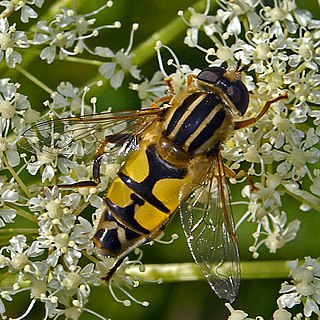
Helophilus trivittatus is a species of Palearctic hoverfly.
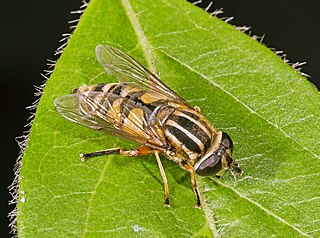
Helophilus are a diverse genus of moderate to large hoverflies, that appear somewhat bee-like. Larvae filter-feed in organic rich water. All Helophilus adults have a distinctive lengthwise striped thorax and a transverse striped abdomen.
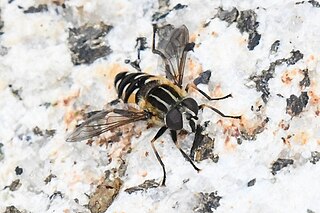
Helophilus groenlandicus, the Black-margined Marsh Fly, is a common species of syrphid fly. Hoverflies can remain nearly motionless in flight. The adults are also known as flower flies for they are commonly found on flowers, from which they get both energy-giving nectar and protein-rich pollen. Though common the larvae of this species like many other Helophilus are not known but the larvae of other species in this genus are associated with wet decaying organic material, particularly accumulations of decaying vegetation in ponds and mud and are a so called rat-tailed type.

Lejops is a genus of hoverflies, closely related to the genera Helophilus, Quichuana and Mallota.

Eristalini is a tribe of hoverflies. Several species are well-known honeybee mimics, such as the drone fly Eristalis tenax, while other genera such as Helophilus and Parhelophilus exhibit wasp-like patterns of yellow and black stripes, both strategies to avoid predation by visual predators such as birds.
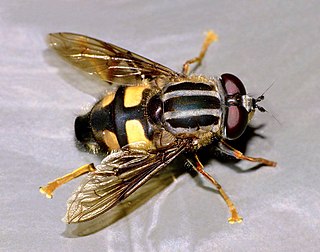
Helophilus seelandicus, commonly known as the three-lined hoverfly, is a hoverfly endemic to New Zealand. The common name corresponds to the three black lines behind the insect's head.
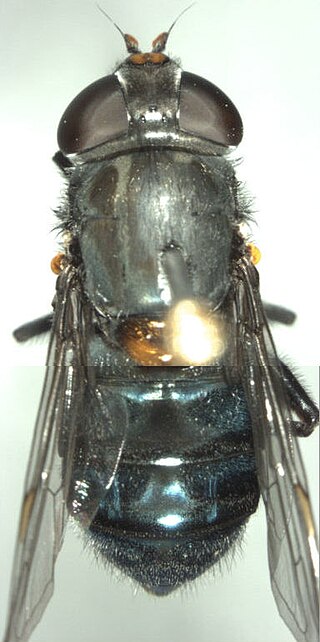
Helophilus hochstetteri, commonly called the metallic blue hoverfly is a native hoverfly of New Zealand.
Gozmanyina majestus is a species of cosmochthoniid in the family Cosmochthoniidae.

Chimarra is a genus of little black caddisflies in the family Philopotamidae. There are more than 630 described species in Chimarra.

Helophilus fasciatus, the narrow-headed marsh fly, is an abundant species of syrphid fly observed throughout the United States and Canada. Hoverflies can remain nearly motionless in flight. The adults are also known as flower flies for they are commonly found on flowers, from which they get both energy-giving nectar and protein-rich pollen. The larvae of this genus are associated with wet decaying organic material, particularly accumulations of decaying vegetation in ponds and mud and farmyard manure or silage. The adults of this species lays eggs on vegetation overhanging the water. The larvae hatch and drop into the water.

Helophilus lapponicus, the Yellow-margined Marsh Fly, is a common species of syrphid fly observed across northern North America, northern Europe, Greenland and Siberia. Hoverflies can remain nearly motionless in flight. The adults are also known as flower flies for they are commonly found on flowers, from which they get both energy-giving nectar and protein-rich pollen. Though common the larvae of this species are not known but the larvae of other species in this genus are associated with wet decaying organic material, particularly accumulations of decaying vegetation in ponds and mud and are a so called rat-tailed type.

Helophilus obscurus , the Obscure Marsh Fly, is a common species of syrphid fly observed throughout Canada and the northern United States and Rocky Mountains. Hoverflies can remain nearly motionless in flight. The adults are also known as flower flies for they are commonly found on flowers, from which they get both energy-giving nectar and protein-rich pollen. The larvae of this genus are associated with wet decaying organic material, particularly accumulations of decaying vegetation in ponds and mud and farmyard manure or silage the larvae of this species are not known.

Helophilus latifrons, the Broad-headed Marsh Fly, is a species of syrphid fly observed throughout the United states, in lower Canada and the mountains on Mexico. Hoverflies can remain nearly motionless in flight. The adults are also known as flower flies for they are commonly found on flowers from which they get both energy-giving nectar and protein rich pollen. The larvae are aquatic feeding on decaying vegetation.

Helophilina is a subtribe of rat-tail maggot flies in the family Syrphidae. There are about 19 genera and more than 180 described species in Helophilina.
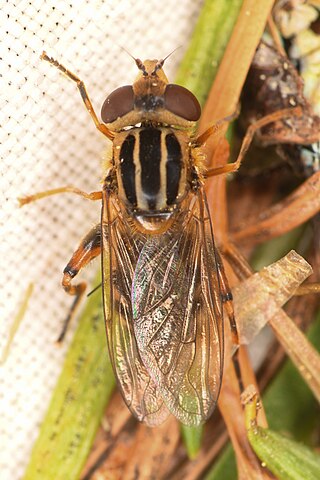
Eurimyia stipata, the long-nosed swamp fly, is a very common species of syrphid fly observed across northern North America. Syrphid flies are also known as Hover Flies or Flower Flies because the adults are frequently found hovering around flowers from which they feed on nectar and pollen. Adults are 11.7–17.1 mm (0.46–0.67 in) long with a striped scutum and sawtooth yellow abdominal spots. Larvae of this genus are aquatic.















